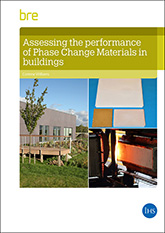Assessing the performance of Phase Change Materials in buildings
In December 2016, BRE published Assessing the performance of Phase Change Materials in buildings (FB 84), written by Corinne Williams.
Phase Change Materials (PCMs), or latent heat storage materials are an emerging technology in the UK construction industry. They have a large specific latent heat capacity, and can help improve the thermal performance of, and thermal comfort in low thermal mass buildings by lowering the peak temperatures resulting from extreme external temperature changes and preventing overheating.
This publication provides an overview of PCM building products and available methodologies for assessing them. It focusses on PCMs as part of a passive / fabric / thermal mass approach and will be of interest to specifiers, designers, installers, approving authorities, manufacturers, fire safety risk assessors and other interested parties.
The first part provides an introduction to PCM building products, covering; what they are and how they work, their benefits, current technical developments and available products. The second part covers testing and evaluation methodologies for long-term thermal performance, environmental impact, structural performance, health and safety considerations, and performance in fire and quality standards.
Its contents include:
- Acknowledgements
- Executive summary
- Glossary
- Introduction
- Assessment of PCMs and methodologies
- Quality schemes for PCM-specific attributes
- Conclusions and recommendations
- References
- Endnotes
The author Corinne Williams answered some questions about the publication:
| Did you have to test several cocktails during the writing of this publication? |
No! The ice cube example is a simple way to explain how PCMs work. Ice is a commonly used and well-known PCM.
An ice cube absorbs heat from a drink. When the ice cube reaches its melting temperature, it changes phase – from a solid to a liquid – and it absorbs large amounts of energy (at constant temperature) and cools the drink in the process.
| What are PCMs? |
A PCM is a material or substance which when changing its state – for example, from solid to liquid or liquid to solid – is capable of storing or releasing large amounts of energy at a constant temperature (the transition temperature). PCMs are referred to as latent heat storage materials.
| How are PCMs used in construction? |
PCM construction products need to be considered as part of the overall package of temperature control measures in a building and early specialist advice is desirable to ensure they are applied correctly and appropriately.
They can be used to provide thermal mass to buildings with low thermal mass to improve the thermal performance and indoor comfort.
PCMs incorporated into different construction products are available. Most of their applications are for inside buildings, such as ceilings and walls. PCM construction products come in various physical forms such as panels, plaster, boards and tiles and are available for different operating (or transition) temperatures.
PCMs in construction products simply absorb latent heat energy from the indoor environment when they change from solid to liquid when the indoor air temperature reaches the transition temperature, during the day. This process needs to reverse when the temperature drops during the night so the cycle can restart the next day.
| Where are PCMs being used? |
There are a number of demonstration and exemplar buildings where PCMs have been installed, including:
- The east wing of Somerset House, London, using clay boards containing PCM.
- The visitor centre at the BRE Innovation Park, Ravenscraig, Lanarkshire, incorporating a PCM ceiling panel system.
- The BASF Research House at the University of Nottingham, using PCM wall boards.
You can purchase the title at BRE Bookshop.
This article was originally published here on 15 Dec 2016 by BRE Buzz. It was written by Sheila Swan.
--BRE Buzz
[edit] Related articles on Designing Buildings Wiki
Featured articles and news
The UK's Modern Industrial Strategy: A 10 year plan
Previous consultation criticism, current key elements and general support with some persisting reservations.
Building Safety Regulator reforms
New roles, new staff and a new fast track service pave the way for a single construction regulator.
Architectural Technologist CPDs and Communications
CIAT CPD… and how you can do it!
Cooling centres and cool spaces
Managing extreme heat in cities by directing the public to places for heat stress relief and water sources.
Winter gardens: A brief history and warm variations
Extending the season with glass in different forms and terms.
Restoring Great Yarmouth's Winter Gardens
Transforming one of the least sustainable constructions imaginable.
Construction Skills Mission Board launch sector drive
Newly formed government and industry collaboration set strategy for recruiting an additional 100,000 construction workers a year.
New Architects Code comes into effect in September 2025
ARB Architects Code of Conduct and Practice available with ongoing consultation regarding guidance.
Welsh Skills Body (Medr) launches ambitious plan
The new skills body brings together funding and regulation of tertiary education and research for the devolved nation.
Paul Gandy FCIOB announced as next CIOB President
Former Tilbury Douglas CEO takes helm.
UK Infrastructure: A 10 Year Strategy. In brief with reactions
With the National Infrastructure and Service Transformation Authority (NISTA).
Ebenezer Howard: inventor of the garden city. Book review.
The Grenfell Tower fire, eight years on
A time to pause and reflect as Dubai tower block fire reported just before anniversary.
Airtightness Topic Guide BSRIA TG 27/2025
Explaining the basics of airtightness, what it is, why it's important, when it's required and how it's carried out.
Construction contract awards hit lowest point of 2025
Plummeting for second consecutive month, intensifying concerns for housing and infrastructure goals.
Understanding Mental Health in the Built Environment 2025
Examining the state of mental health in construction, shedding light on levels of stress, anxiety and depression.























